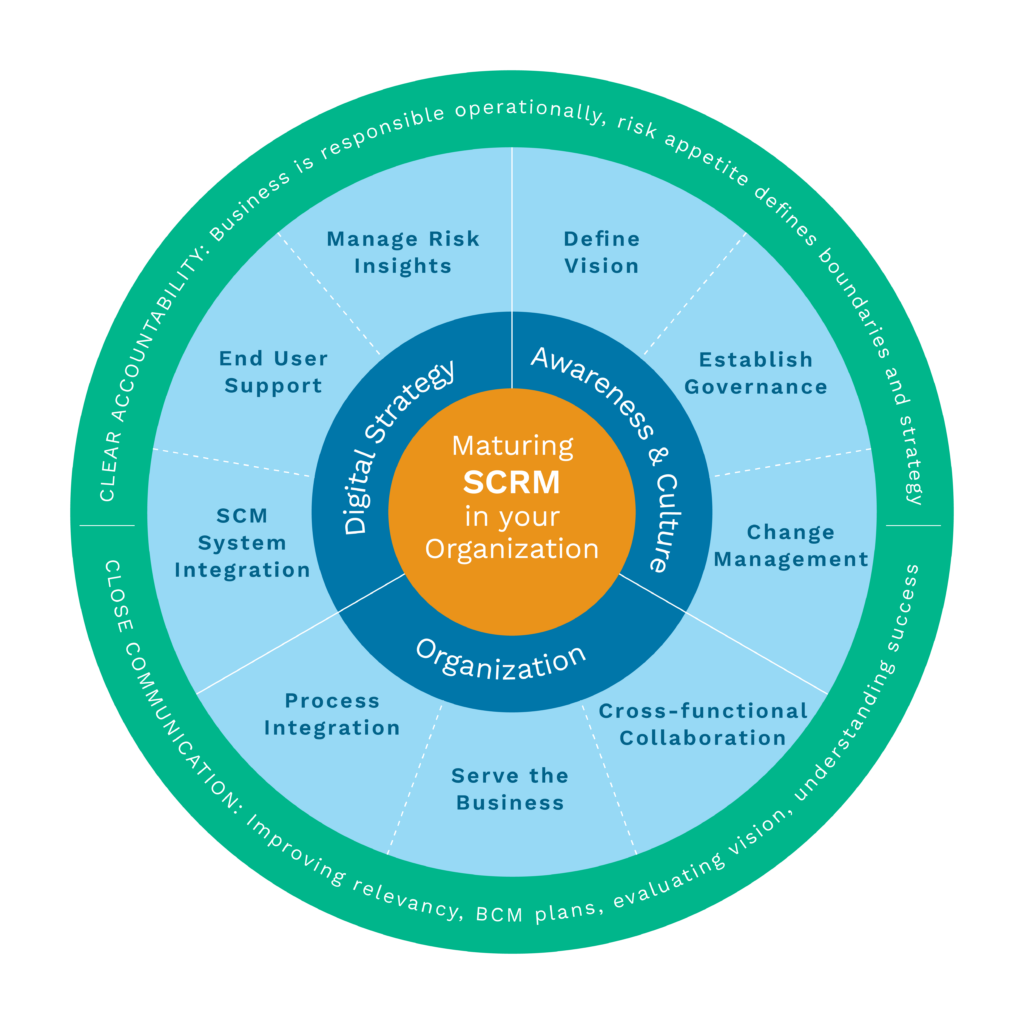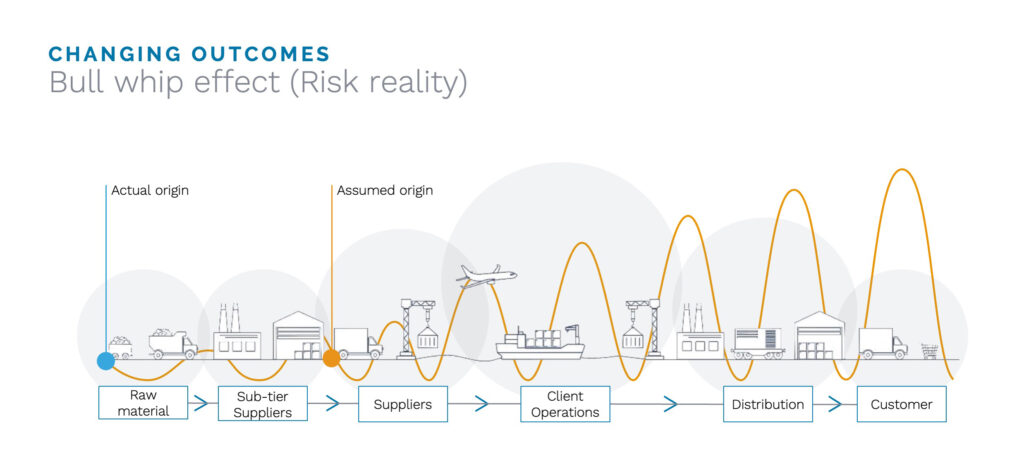A Deloitte Touche Tohmatsu survey found that 85% of global supply chains experienced at least one disruption in the past 12 months. That was before COVID-19. Since the epidemic, Supply Chain Dive reported that 73% of companies experienced a “detrimental” supply-side disruption due to the pandemic – that is on top of the typical disruptions like natural disasters, supplier delay, part shortages, and cyber security each year. Perhaps never before has the supply chain been more at risk.
What is a supply chain risk management assessment?
Companies have been forced to look closer at their supply chains, performing a supply chain risk management assessment post-pandemic. A supply chain risk management assessment is the practice of looking at the various supply chain components to determine where risks may lie and where improvements can be made to either lessen the risk or speed response if the threat materializes.
The assessment must go beyond critical Tier 1 and Tier 2 suppliers. According to the Everstream Analytics and The Business Continuity Institute (The BCI), 40% of survey respondents plan to perform greater due diligence going forward due to the pandemic, including Tiers 3 and 4 suppliers at the least. Clearly, companies are getting the message that a supply chain risk management assessment is their best bet to minimize their risks.

Figure 1: A comprehensive supply chain risk management policy supports financial and operational business growth.
The key to supply chain resilience is to build an agile business that can respond quickly to changing market conditions, customer demand, external threats (like COVID-19 and trade tariffs), and other potential disruptors. All of these can have detrimental effects on costs, margins, product quality, and time to market.
The supply chain risk management assessment may not uncover every potential threat, but it goes a long way to anticipating as many “what-ifs” as possible so companies can model various response strategies. Every part of the supply chain is dependent on other parts. Even when one component is going well, a hiccup somewhere else can still spell disaster down the line. A complete assessment is necessary for effective supply chain risk mitigation.

Figure 2: Catching risk early is how to mitigate the expanding bullwhip effect.
How to mitigate supply chain risk in 5 steps
Proactive risk management begins with understanding as many of your risks as possible. That same Deloitte survey found that companies that proactively manage supply chain risk spend 50% less to manage supplier disruptions than companies that say they aren’t proactive. Managing risk from beginning to end not only helps your company reduce its risk exposure and costs, it also gives you a competitive advantage as you continually improve your resilience.
You can personalize the assessment to fit your business; however, standard steps are as follows:
Step 1: Take inventory of your suppliers
Risks can be anywhere at any time. While there is no way to identify every potential risk, you can start with what you do know and work from there. Look at your suppliers and their practices first because if they fail, it will make it that much more difficult for you to succeed.
- Are they meeting their SLAs and other contractual obligations?
- Do they consistently meet your standards for quality, on-time delivery, environmental protection, and worker safety?
- Are their invoices precise and accurate, or are you having to constantly dispute charges, order quantities, and other billing irregularities?
- How easily and quickly do they resolve disputes?
- Do they maintain a positive corporate reputation?
For any suppliers that are missing the mark, it may be time for a change or maybe a direct conversation. The supply chain risk management assessment will help you identify which relationships need to be strengthened, severed, or maintained as is. When you can get a complete picture of your supplier performance, looking at their past and identifying trends, you can make more informed decisions on whether diversification would be beneficial or if you can trust your current situation.
Step 2: Assess the environment
Your suppliers introduce the most obvious risks, but there are environmental risks that can wreak just as much havoc. Natural disasters and weather-related events can devastate a supply chain. Even small events can cause delays and damaged goods.
A hurricane, fire, or flood can have long-term effects on factories, roads, natural, and workers. Up to 60% of U.S. small businesses never reopen after such events. A study of 41 major U.S. disasters showed that $1 of lost sales for suppliers led to a $2.4 loss for those further down the supply chain.
Even shorter-term issues such as extreme temperatures, severe storms, and significant rain or snow can delay or damage shipments. If your company or its suppliers and their carriers (and all of the suppliers and carriers that they are dependent upon) face any of these environmental hazards, how likely will you be able to get products out the door on time to meet your own commitments?
For many companies, using intelligent software to help identify and score risks is the most efficient and effective way to truly visualize and mitigate risk across the supply chain. Companies like Everstream automate risk detection, analysis, and decisioning so that businesses have greater confidence as they are seeing the entire picture.
The software continuously assesses environmental, infrastructure, and social risks and then determines how likely and severe those risks are, prioritizing more urgent risks with easily identifiable risk scores. It also presents various mitigation strategies to speed decision-making so that companies can respond faster.
Step 3: Consider social and economic conditions
There are also political tensions brought on by trade wars and tariffs, labor strikes, social unrest, economic downturns and other situations that you have little control over and much to lose from if you don’t understand how they can impact your supply chain. COVID-19 revealed the dangers of companies being overly-dependent upon single suppliers, particularly those based in China.
If your supply chain involves stakeholders in unstable markets who may not be able to deliver as promised, you will feel the effects as your customers expect you to still meet your obligations. An assessment of these suppliers will help you determine your risk exposure and again, whether supply chain diversification may be necessary to ensure business continuity.
Gartner says, “While companies routinely seek to make their supply chains more competitive, very few have considered vulnerability to trade risks. The current uncertainties around tariffs offer companies that run highly agile supply chains a chance to gain a competitive advantage in the drastically changing global trade landscape.”
As such, companies that perform routine supply chain risk management assessments seek more than to just determine risks but to identify opportunities where they can leap ahead of the competition.
Step 4: Qualify the risks
Not all risks are worth dedicating mitigation efforts towards — at least not yet. For each shipment, supply chain leaders need to know which risks are imminent, which are probable, and which need to simply be on the radar. By prioritizing risks based on their potential timeframe and severity, you can focus your attention on what really matters instead of wasting resources on risks that may never happen.
Risk scoring is a visual way to qualify risks based on certain characteristics that you deem valuable. You need to establish your risk tolerance first, defining the scoring system and determining the risk threshold that will trigger an action. When everyone understands the numerical system and what it signifies, they will spend less time on discussion if they should respond because the score becomes the benchmark.
Step 5: Leverage data for strategies to mitigate supply chain risk
Steps one through four are those included in the actual supply chain risk management assessment. Once the assessment is complete, the next steps involve risk mitigation strategies. A risk mitigation plan will consider the data collected from the assessment to determine what actions should take place to reduce risk and seize opportunities to improve.
Work as a team, bringing in cross-functional resources to share perspectives, experiences, and recommendations on how best to mitigate each identified risk. Utilize technology where you can get it, such as Everstream’s predictive analytics. Automating the process will dramatically speed risk identification and mitigation decisioning.
Risks will continue to plague the supply chain; however, an accurate supply chain risk management assessment, effective mitigation protocols, and the right technology will give you the best opportunity to not only ride the storm, but come out ahead.
To learn more download our report: Understanding Supply Chain Risk Management